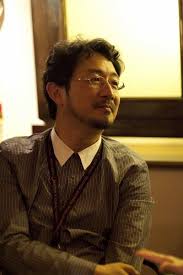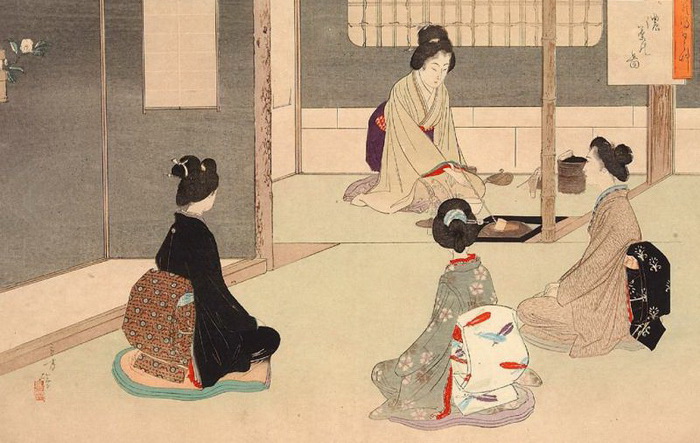MASAHIRO YASUDA AND HIS THEATER “YAMANOTE”
 With this pensive, phlegmatic (as it seemed to me when I first met) man I first met in the summer of 2000, during the Moscow Theater Olympics. Having put Meterlinka’s Blue Bird at his Yamanote Theater in Tokyo, he wanted to talk with one of the Russian theater specialists and find out how Stanislavsky’s performance at the Moscow Art Theater looked like. Translator Yukiko Kase, a very nice girl who graduated from the philological faculty of Moscow State University here in Moscow and defended her dissertation on Gogol’s work, called me and asked for a meeting.
With this pensive, phlegmatic (as it seemed to me when I first met) man I first met in the summer of 2000, during the Moscow Theater Olympics. Having put Meterlinka’s Blue Bird at his Yamanote Theater in Tokyo, he wanted to talk with one of the Russian theater specialists and find out how Stanislavsky’s performance at the Moscow Art Theater looked like. Translator Yukiko Kase, a very nice girl who graduated from the philological faculty of Moscow State University here in Moscow and defended her dissertation on Gogol’s work, called me and asked for a meeting.
The day we spent partly at my home, analyzing the little that we managed to get about the Mkhatov’s “Blue Bird” (sketches of costumes and scenery, photographs, memoirs of the participants), partly in the Kuskovo park, the summer cottage of Count Sheremetyev.
Communication was intense. The percentage of questions Yasud asked was many times greater than the percentage of questions I asked him. Therefore, it will be more accurate to determine the nature of our conversation as his questions and my monologues. And the subjects of interest were such that, when satisfied, they meant global calculations and they required much more time than one day. As already mentioned, we began by studying the details of the design of the performance of the Blue Bird: decorations, costumes, props. Questions rained like cornucopia, and their character really surprised me. Yasuda did not like what he saw in the pictures. He certainly wanted to know from what, from what fabric the backdrop was sewn, what material was used to make the stuffed Bluebird, how animal masks work, at what height and with which decorations were fixed. Then, when I partially managed to satisfy his curiosity in this regard, we switched to talking about the features of various methods of acting. However, as I hope, it is clear that a story about the formation of a creative method, for example, Meyerhold, requires at least ten to fifteen academic hours. Guided by a tireless and inquisitive Japanese, I was able to outline the picture of the activities of Stanislavsky, Vakhtangov, Meyerhold, Mikhail Chekhov, talk a little bit about the different directions of philosophical thought in Russia, about the peculiarities of the Russian character, and finally, about running – about our conditions perishable life and about “what the Russian people are striving for” (the answer to the last question was extremely lengthy and, no matter how Yasuda tortured me, it did not become clearer). At around 8 p.m. we boarded the subway train, and Yasuda dozed off right there. “Yeah,” I thought, “you have a limit, after all.”
At Waseda University in Tokyo, where Yasuda, together with like-minded people, began his theatrical activities and organized a team, like in many other educational institutions in Japan, a comprehensive, synthesized training system was introduced. Here, students are not divided into separate faculties (painting, musical theater, acting, theater, etc., as in Russia), but they study all disciplines in a complex. Talking about the advantages and disadvantages of such a system is the topic of a separate article, let’s just say that the Japanese themselves, who left directly from the University, respond with restraint and not even very friendly. However, the undoubted advantage of this method of education is a fairly high overall cultural level. And directly for the Japanese, this is also useful because they are a nation that carefully preserves traditions. One can feel the essence of tradition only by studying culture as a whole, and not just one part of it.
One of the most curious phenomena in Japanese culture is the subconscious desire of people looking for new means of expression – a new, modern way of expressing oneself – not to part with what was created earlier. Previously – not a few dozen, but several hundred years ago. The European consciousness, the basis of which is egocentrism, a personal manifestation, has lost the need to look back at the past. In Eastern thinking and outlook “alter ego” does not play such a role. The person here does not oppose himself to the world and society. On the contrary, the tradition of the East and, above all, the Japanese tradition presupposes a harmonious combination of man (here man is a generalized concept) with the whole world and, first of all, with nature. And this does not mean at all that Eastern civilization depersonalizes a person, does not allow him to express himself to the end. Japanese culture, like any other, was formed and developed thanks to individual outstanding personalities. Only these personalities had slightly different goals than Western figures: they sought to create, above all, a canon, a single direction that other generations could follow. In Russia, for example, it is difficult to maintain a tradition not so much because the general level of culture is falling (although this fact is extremely acute about itself), but because the idea and its creator are too closely linked.




